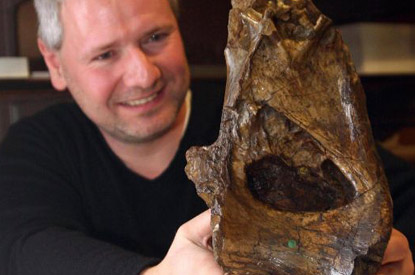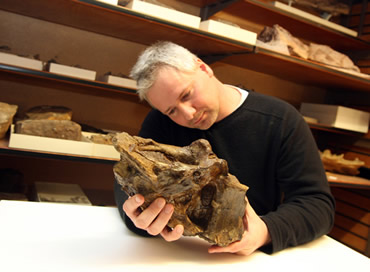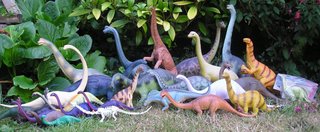Doctoral Pupil & Darren Discover Dino
Posted by: Loren Coleman on November 16th, 2007

A dino in the dungeon?
This is more big news from the forgotten basements one finds in museums, the hidden vaults and dingy dungeons that delight those that look in them. What was discovered?: Merely a brand new dinosaur. It will forever be known as Xenoposeidon proneneukos Taylor & Naish, 2007.
Congratulations to our buddy Darren Naish and his student.
Doctoral pupil Mike Taylor (above and below with the fossil specimen) and Darren Naish, Ph. D., have identified this dinosaur bone in the National History Museum of London’s collection as belonging to a new family of sauropod dinosaur.

Darren Naish, whom I recently discussed here, gets to the heart of the matter in this passage from his new blog on Xenoposeidon proneneukos:
Among the bits and pieces [that] sat in the NHM collection, Mike [Taylor] stumbled upon, and became intrigued by, the probably non-brachiosaurian BMNH R2095. I’d never looked at R2095 (though given my work on Wealden sauropods (Naish 2005, Naish & Martill 2001, 2007, Naish et al. 2004) maybe I should have), but I did know of it from Lydekker’s description and thought that it looked sort of odd. After Mike and I got corresponding on it we ended up co-authoring a description. The big deal is that BMNH R2095 isn’t just some random vertebra that might have belonged to any old sauropod: it’s a radically new, highly divergent specimen, representing a quite novel suite of anatomical features, and apparently indicating the presence of a hitherto undocumented sauropod lineage. ~ Darren Naish, “The world’s most amazing sauropod,” Tetrapod Zoology, November 15, 2007.

The Natural History Museum of London has formally announced the story in great detail.
A previously unknown family of dinosaur has been discovered by a University of Portsmouth researcher.
Mike Taylor, a PhD student, spotted an unusual looking bone while carrying out research in the Natural History Museum’s Palaeontology Department’s dinosaur collection.
‘It leapt out at me as being different,’ said Taylor. ‘I’ve spent the last five years doing nothing but looking at sauropod vertebrae and I immediately realised it was something strange.’
‘It was unmistakably a dorsal vertebra (part of the backbone) from a sauropod, but it didn’t look like any dorsal I’d ever seen before.’

Hopefully, someday, soon, a company will make a replica of Xenoposeidon proneneukos for Darren to add to his personal sauropod collection.
Sauropods
The find is a new sauropod, a member of a group of dinosaurs recognisable by their large bodies, long necks and small heads. It lived about 140 million years ago and has been named Xenoposeidon , which roughly translates to mean ‘alien sauropod’.Sauropods were herbivores. The largest were as big as a whales and weighed up to 70 tonnes, which is about as heavy as twelve elephants.
Over 100 years in Museum collections
The bone has been in the Museum’s collections since its discovery in the early 1890s in Ecclesbourne Glen, near Hastings, by fossil collector Philip James Rufford.
It was given a brief review by English palaeontologist Richard Lydekker after which it was untouched for the next 113 years.
‘The Natural History Museum collection is so huge that it’s impossible for anyone to know everything that’s in there,’ says Taylor. ‘It’s full of ancient treasures waiting to be rediscovered by scientists.’
Dr Paul Barrett, dinosaur expert at the Museum, explains, ‘we have thousands of dinosaur specimens in our collection, many of which are used by scientists from all over the world for important and ongoing research. Because of their work, dinosaur bones are being constantly reassessed and our collections still offer us lots of surprises.’

No precise location
Sussex is considered a rich hunting ground for dinosaur remains but because no precise record of where the bone was dug up was kept, palaeontologists cannot go looking for more of the skeleton.Bone detectives
Taylor and fellow palaeontologist Dr Darren Naish know the preserved bone came from near the hip area of the dinosaur. From this they made an informed guess about the size and shape of the animal and were able to establish why Xenoposeidon is not only a new genus and species, but a new family of dinosaur.Taylor said, ‘The big advantage we had over Lydekker was 113 years of research, during which time 100 sauropods had been named, many of them from excellent remains.’
‘There were lots of animals we could compare our specimen with, and lots of useful papers describing and discussing them. It was quickly apparent that my first instinct had been right: this bone had belonged to a previously unknown species.’
Xenoposeidon will be named and described in the November 15, 2007 edition of Palaeontology , the journal of the British Palaeontological Association.“New dinosaur in Museum collection,” press release, Natural History Museum, London, UK, Nov. 15, 2007.
About Loren Coleman
Loren Coleman is one of the world’s leading cryptozoologists, some say “the” leading living cryptozoologist. Certainly, he is acknowledged as the current living American researcher and writer who has most popularized cryptozoology in the late 20th and early 21st centuries.
Starting his fieldwork and investigations in 1960, after traveling and trekking extensively in pursuit of cryptozoological mysteries, Coleman began writing to share his experiences in 1969. An honorary member of Ivan T. Sanderson’s Society for the Investigation of the Unexplained in the 1970s, Coleman has been bestowed with similar honorary memberships of the North Idaho College Cryptozoology Club in 1983, and in subsequent years, that of the British Columbia Scientific Cryptozoology Club, CryptoSafari International, and other international organizations. He was also a Life Member and Benefactor of the International Society of Cryptozoology (now-defunct).
Loren Coleman’s daily blog, as a member of the Cryptomundo Team, served as an ongoing avenue of communication for the ever-growing body of cryptozoo news from 2005 through 2013. He returned as an infrequent contributor beginning Halloween week of 2015.
Coleman is the founder in 2003, and current director of the International Cryptozoology Museum in Portland, Maine.










This is one of the funny things about fossils. Sometimes they are dug up and packed away in a museum somewhere without anyone knowing what a remarkable find they are. Important fossils can slip through sometimes, they are just simply not recognized for what they are, and this is not the first time a new species has been identified from fossils already collected and stored away. For all we know, the fossil evidence for Bigfoot is not only out there, but it has already been found and is collecting dust in a collection somewhere. Fascinating article.
This does not only happen with fossils, a lot of animals were also just discovered in old museum archives, for example the giant and most probably extinct gecko Hoplodactylus delcourti. But it is the same thing with archeological museums, there are surely still many unrecogniced treasures in old archives.
If you live near any museums with collections worth examining one might consider offering one’s voluntary service. Most of these educational/scientific institutions (or National Parks, for that matter) rely to a surprising degree on intelligent, motivated, folks who wish to apply their energies in a voluntary capacity in exchange for proximity to the treasures only they can appreciate. There is no better behind the scenes tour than when you lead one yourself as a docent.
I saw Taylor on Headline News yesterday.
Apparently his interest in Dinosaurs began with him watching Jurassic Park.
I know a lot of people who began like that.
Well, I was already very interested in dinosaurs and related stuff long before Jurassic Park…
Wooow 8-(
I’m gonna start a new entry on Wikipedia for Dedication, and I’m gonna put this guy’s photo in it!
mistery_man, I was thinking exactly the same thing…
Hmmmm. dogu4 that is really not a bad idea at all. I have never thought about volunteering at some place like the museum. A person can really get some hands on experience with the exhibits they have on display. And also exhibits that are barrowed here and there. Just documenting all the stuff being brought in would be kool. And the people you get a chance to meet is just awesome. People like Jeff Meldrum, Peter Byrne and Bob Pyle to name a couple. And if your lucky, maybe even a guy like Loren if he is town. I think I myself would have a hell of time in the bush. Doing something like Bob Pyle did in his book Where BigFoot Walks, would be one awesome experience. I really do want to spend some time in the forest of Washington. A Cabela’s store near me is having a Grand Opening today. I think I will be paying that store a visit very soon. I already told the little woman to prepare herself.
DARHOP- It is an excellent idea. I did what Dogu4 mentioned awhile back in my university days and I can personally say it is worth it. If you appreciate these sorts of treasures and relics, and it sounds to me like you do, then I guarantee you will have an educational, fascinating time. You are absolutely correct that there is no better way to learn about these things than actually seeing them right there in front of you. You can learn an amazing amount about science and natural history by working together with these folks and seeing things with your own eyes. If getting out in the field is more your thing, you can do that too in some national parks, again as Dogu4 mentioned. A great way to do your part, see nature, and learn more about the world we live in. I highly recommend it to you if you have the time and the means.
There was another museum that recently discovered that they had a complete Barosaurus skeleton in their collection, but didn’t know it because the bones were all scattered around the basement in different drawers and cabinets and such. Like Xenoposeidon, it was a Sauropod too. If you can lose an entire Sauropod in an itemized museum collection, what other animals can be overlooked?
I was the sort of 5-year-old kid that said “paleontologist” when he was asked what he wanted to be when he grew up. Since I never grew up, I suppose it’s nice to know I might still be able to enter the field as a volunteer. As much as I’d love to do the Roy Chapman Andrews thing, rooting around in dusty old basements is probably more my thing.